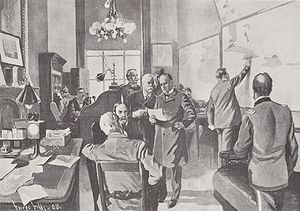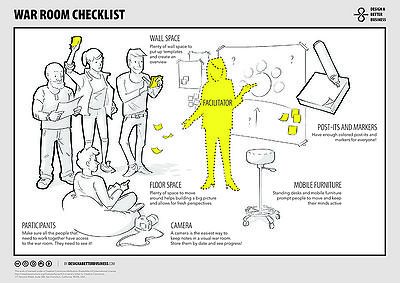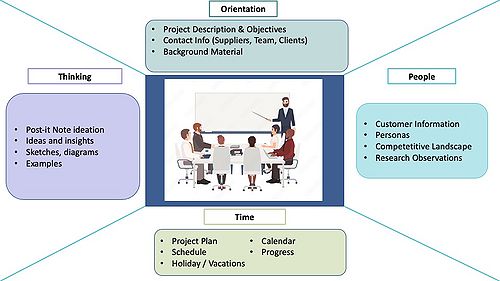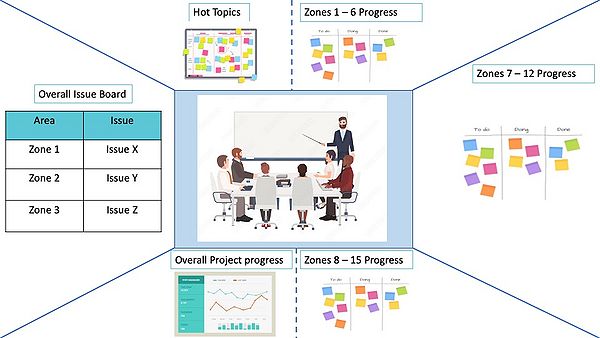Project War Rooms: Physical vs. Virtual
(→Physical Project War Rooms) |
(→Physical Project War Rooms) |
||
| Line 56: | Line 56: | ||
# Record your work by camera or translating it to an online work environment to track progress <ref name="ExampleWarRoom"> Van Der Pluijm, Erik, "Welcome to the war room", Available at: https://designabetterbusiness.com/2016/12/02/welcome-to-the-war-room/ </ref> | # Record your work by camera or translating it to an online work environment to track progress <ref name="ExampleWarRoom"> Van Der Pluijm, Erik, "Welcome to the war room", Available at: https://designabetterbusiness.com/2016/12/02/welcome-to-the-war-room/ </ref> | ||
| − | [[File:WarRoomGeneral.jpg|right|thumb|500px|Figure 1: | + | [[File:WarRoomGeneral.jpg|right|thumb|500px|Figure 1: Generic example of war room layout. <ref name="art"> The Art of WarRoom, the user called "SapientNitro" (2014) (Slideshow: http://www.slideshare.net/rmurray/the-art-of-warroom) </ref>]] |
| Line 65: | Line 65: | ||
In the image to the right, it can be seen what each of these sections should include. | In the image to the right, it can be seen what each of these sections should include. | ||
| − | Orientation includes critical information such as contact information to all relevant parties involved in the project. This helps to eliminate the potential excuse that a phone number wasn't available, or a team member being unaware of which suppliers there are etc. Orientation can also include the project mission, "why is this project occurring?" and the project description, "This is how we are going to execute.". It is also possible to include background material on the vendors, suppliers and other relevant parties if needed. | + | ''Orientation'' includes critical information such as contact information to all relevant parties involved in the project. This helps to eliminate the potential excuse that a phone number wasn't available, or a team member being unaware of which suppliers there are etc. Orientation can also include the project mission, "why is this project occurring?" and the project description, "This is how we are going to execute.". It is also possible to include background material on the vendors, suppliers and other relevant parties if needed. |
Time should give an overview of the project schedule and progress. When a project member walks into the room, they should be able to get an idea of where in the project the team currently is and how far along they are. Different degrees of detail can be included. Furthermore, events such as holidays, vacation days, closing days for production etc. can be included. These days should be relevant for the whole team to know about, to keep everyone in the loop. It can be a good idea to have a calendar overview for this information. | Time should give an overview of the project schedule and progress. When a project member walks into the room, they should be able to get an idea of where in the project the team currently is and how far along they are. Different degrees of detail can be included. Furthermore, events such as holidays, vacation days, closing days for production etc. can be included. These days should be relevant for the whole team to know about, to keep everyone in the loop. It can be a good idea to have a calendar overview for this information. | ||
Revision as of 09:33, 7 April 2023
Written by Ellen Cathrine Luke
Abstract
Project war rooms are a crucial tool in project management. They allow for a group or team to have a visual and collaborative space to plan, strategize, and track progress. Historically, war rooms have been physical rooms, where teams would gather to work on the project together. However, due to the COVID-19 pandemic, increased amounts of remote work are arising and the format of war rooms has adapted to this change. Virtual war rooms have become increasingly popular, allowing team members to work together from different locations and still access all the necessary information and tools. Some of these virtual platforms are sourced by companies such as IBM and Cisco[1]. With these virtual platforms, the challenge for project teams now becomes, “How do I provide that same data to the project team that we used to have in hard copy form in this room to the people no matter where they are on a real-time basis?”, as said IBM Project Manager Jerry Perone, PMP [2].
Despite the change in format, the importance of war rooms remains the same. They provide teams with a structured environment to tackle complex projects, and the visual nature of war rooms facilitates better communication and collaboration. In the post-pandemic world, virtual war rooms are becoming a necessity for organisations to manage their projects effectively, regardless of location. Both the physical and virtual format of a war room have their advantages and limitations, which will be explored further in the following sections.
Contents |
Introduction
Definition & Historical Overview of Project War Rooms

A Project War Room, also referred to as situation rooms, control rooms and command centers, is a dedicated space or virtual platform where project teams can gather to visually plan and track the progress of a project. It is a collaborative environment where all stakeholders can have a clear understanding of the project's goals, tasks, and timeline [4] . The concept of project war rooms has existed for decades, particularly used throughout World War II and since the 1960’s. The concept has since been used in other contexts and has become an essential tool in project management [5].
Project war rooms were inspired by the military, where they would use the rooms to plan tactics and strategies to take down the enemy. Miniature models and figures would be laid out on tables, creating a visual and collaborative approach for leading generals. Since the 1950’s and 60's, project war rooms became physical spaces, which were often located within an organisation's headquarters. These would be set up as continuous spaces with walls covered in charts and information relevant to the project. The wording "war room" can at times have a negative connotation. It expresses that a project is in crisis mode and not going as planned. A war room can instead be viewed as a "solution room", promoting active involvement from the team, hereby improving communication and collaboration. The aim was to create a visual and interactive environment where the project team could work together, brainstorm, and make quick decisions [5]. An example of where a war room is crucial, is when a project team needs to keep track of progress. At the beginning of a project, several short- and longterm factors are unknown, but that does not mean they should be forgotten. By allocating physical or virtual space for collaborative planning, a team can help ensure that all elements are accounted for, increasing the chance of executing on time and on budget.
Since the COVID-19 pandemic, the format of project war rooms has had to shift. Virtual war rooms have become increasingly popular, allowing team members to work together from different locations while still having access to all the necessary information and tools. The virtual environment provides the same collaborative and visual benefits as a physical war room, but with the added convenience of remote access [1].
Regardless of the type, project war rooms allow organisations to manage their projects effectively and are an essential tool in today's fast-paced and ever-changing business environment. They provide teams with a structured environment to tackle complex projects and the visual nature of war rooms allows for better communication and collaboration.
Physical Project War Rooms
Creating a War Room

War rooms can vary from being high-tech rooms with digital screens displaying information, to low-tech with whiteboards, post-it notes and hand written additions [5]. When setting up a physical war room, there are several key features that need to be addressed. The space should give the team overview and both show a broad overview and the current state. It is therefore important to agree beforehand, how the war room is going to be used.
The overview should include daily, weekly, monthly, quarterly and even yearly progress and planning, in different degrees of detail. That means, the daily, weekly and monthly schedule should be more detailed than the long term overviews. Understanding the different layers of a project and maintaining the overview is crucial for project execution success.
The initial team should set out to create the skeleton of the room, whereafter experts are invited into the process adjust and assist[5]. Next, it needs to be decided whether or not a purely analog format is used, or if the idea of a hybrid war room is introduced. A hybrid version allows for the analog information on whiteboards and post-it notes to be translated into a digital platform afterwards. This makes the information easier to share with other stakeholders and generally more accessible.
The skeleton of the room includes the following elements:
- Space for the entire project team to sit and move if needed
- Zones for the team to have discussions and ideate
- Wall space for drawing, designing etc.
- Tools such as sticky-notes, drawing tools, paper, white boards.
- Be able to keep the room as is, for the duration of the project
- Adjustable work environment with versatile furniture
- Record your work by camera or translating it to an online work environment to track progress [7]

A key element in the room are the walls or boards, where a project team displays all the information. The war room walls / board can be categorised into general sections such as Orientation, Time, People and Thinking.
In the image to the right, it can be seen what each of these sections should include.
Orientation includes critical information such as contact information to all relevant parties involved in the project. This helps to eliminate the potential excuse that a phone number wasn't available, or a team member being unaware of which suppliers there are etc. Orientation can also include the project mission, "why is this project occurring?" and the project description, "This is how we are going to execute.". It is also possible to include background material on the vendors, suppliers and other relevant parties if needed.
Time should give an overview of the project schedule and progress. When a project member walks into the room, they should be able to get an idea of where in the project the team currently is and how far along they are. Different degrees of detail can be included. Furthermore, events such as holidays, vacation days, closing days for production etc. can be included. These days should be relevant for the whole team to know about, to keep everyone in the loop. It can be a good idea to have a calendar overview for this information.
People incorporates customer information, such as analytics, perhaps important stakeholders that the team needs to be mindful of. It can be useful to include a competitive landscape if this is relevant for the project. Including insight into different personas can help guide communication in knowing who to get ahold of for different questions and tasks.
Thinking is the section of the war room where free thought can take place. There should be space for post-it note ideation, ideas and insights found along the way and visuals such as sketches and diagrams. This part of the room can help nurture the create process and increase collaboration between team members.
Advantages & Limitations
Having physical war rooms for project teams lets you face the problems immediately. Being together in an inclosed space allows for clear communication and collaboration. There can also be increased productivity, since the team is faced with the problem then and there. The physical setup of a room can aid understanding and provide clear visualisations for everyone, also allowing team members to interact with the tools in the room to get points across. That being said, there are a few, yet critical limiting factors of having a physical war room. As companies grow, more people are needed in crucial meetings such as those in war rooms. Having a room with a set size and capacity will not allow for everyone to fit. This can decrease communication efficiency, if people who are not present need to be informed after the meetings through additional documentation. In addition, people can end up speaking over each other, where the dominant participants will be heard more than the rest. We as humans do not have the ability to manage several conversations at once and must therefore be mindful and let everyone be heard[1]. Furthermore, in the time people are physically together, there are often private notes taken and information scattered in different platforms. If there is inconsistency in the documentation process, information will be misaligned and not useable for future reference.
Virtual War Rooms
The concept of a virtual war room should be able to do the same as a physical one. All relevant stakeholders should be together in one space, sharing ideas and coming up with solutions. Within a digital platform, there is ease of access to information, which can be retrieved immediately by any stakeholder. A platform as such can vary in layout and include different components, such as dashboards, digital whiteboard or progress reports. The goal is still to gather project teams and progress within the project as effectively as possible.
Key Features
Larger companies such as IBM and Cisco have developed solutions for virtual war rooms. IBM's solution ChatOps focuses on being able to communicate across several teams, allowing for breakout rooms and threads to be created. Since all the information is documented in ChatOps, newcomers can easily join and be up to date. Even though it can be difficult for physically present and virtual attendees to have simultaneous conversations, messaging and threaded conversations allows teams to communicate concurrently. IMB's solution is built to invite all people into the war room, whether that be a confident project manager or a reserved developer[1]. . Cisco's virtual war room combines the use of dashboards and notes in a chat room setting. When issues occur, these can be added to the timeline overview, available to all inside the war room. Their focus is to keep everyone informed through real-time, assigning responsibles to the issues at hand and giving an overview to a broader audience[9]. Other solutions such as Kosy's (https://www.kosyoffice.com/use-cases/war-room) does not include all the features of the other two examples, but still allows for documentation, illustration on virtual white boards and their own meeting room design, which can be customized.
Advantages and Disadvantages
Advantages: More Flexibility, Lower Costs, Allows for AI assistance (records meeting minutes, suggests new tasks)
Limitations: Limited Personal Interaction, Technical Challenges, Potential Miscommunication
The virtual war rooms solutions presented by IBM and Cisco aim to simplify and accelerate problem solving. Participants are able to multitask without interrupting others, work together without being physically together and document information for everyone to see. Generally, the virtual war rooms allow for more flexibility, potential reduced cost since a physical room isn't needed, and AI assistance in the form of transcribed meeting notes and suggestions for new tasks. The downside of only having a virtual war room, is the lack of physical collaboration.
Learnings from a Project in Construction
It is important to remember that project war rooms can vary in layout, depending on the type of project. An interview with an engineering manager and the project manager of a production facility at a large pharmaceutical company in Denmark, gave insights into how they prioritise setting up 'solution' rooms (another expression for war room). The walls of the room are split into the sections seen in the image below.

The primary focus of the room are all the issues occurring on the project. Surrounding the room, there is a progress board for the overall project and individual progress being documented for each zone in the facility. This way, the project team can have an overview of the big picture and zoom into different areas. Next, there is a board called "Hot Topics". This is where important tasks are written up and monitored, making sure they are executed on time.
All information regarding the solution room for this project is only documented manually, where a facilitator delegates tasks out and those individuals document their own tasks down. It is important to note that the project was taken over by a new team half way through the process, leading to a new management team setting the current solution room up. This has also meant, that the manual process of documentation has not been translated into a virtual version, simply due to lack of time. Had there been more time, the management team highlighted the usefulness of having a hybrid solution room. This way, people are still able to interact with each other in the physical room, whilst being able to access the information from a digital platform. In other successful project executed by this management team, dashboard tools representing progress of cost and time would be updated in synch with the physical solution room. A hybrid model worked well in these scenarios and are the preferred way of working in the future. Next steps could include trying to synch the predicted time plan with the progress actually occurring. However, the difficulties can be when unforeseen events, such as delays and other supply chain issues, take place. Being able to have a digital time scheduling tool that can take these issues into account would allow for streamlined communication across any team.
Whats the best war room for me?
Conclusion
The Future of Project War Rooms
Growing Importance of Virtual War Rooms
Integration of Physical and Virtual War Rooms
Evolution of Project War Rooms
- ↑ 1.0 1.1 1.2 1.3 Barron, Robert. Solve problems in a virtual war room. Available at:https://www.ibm.com/garage/method/practices/manage/virtual-war-room/
- ↑ Ingebretsen, Mark. Enter the war room. Available at:https://www.pmi.org/learning/library/corporate-war-room-problem-solving-3368
- ↑ Naval History and Heritage Command, War Room, Available at: https://www.history.navy.mil/research/publications/documentary-histories/united-states-navy-s/telegraphy-and-cable/illustrations/war-room.html
- ↑ Kidd, Chrissy. What Is An “IT War Room”?, 2019, Available at:https://www.bmc.com/blogs/it-war-room/#:~:text=Also%20known%20as%20situation%20rooms,any%20type%20of%20project%20management.
- ↑ 5.0 5.1 5.2 5.3 Shaker, Steven, Lessons Learned from War Room Designs and Implementations, 2002, Available at: https://apps.dtic.mil/sti/pdfs/ADA467523.pdf
- ↑ Design A Better Business, War Room Checklist, Available at: https://www.designabetterbusiness.tools/tools/war-room-checklist
- ↑ Van Der Pluijm, Erik, "Welcome to the war room", Available at: https://designabetterbusiness.com/2016/12/02/welcome-to-the-war-room/
- ↑ The Art of WarRoom, the user called "SapientNitro" (2014) (Slideshow: http://www.slideshare.net/rmurray/the-art-of-warroom)
- ↑ AppDynamics by Cisco. Virtual War Rooms. Available at:https://docs.appdynamics.com/appd/22.x/22.6/en/appdynamics-essentials/dashboards-and-reports/custom-dashboards/virtual-war-rooms
- ↑ War Room Layout, Created by: Ellen C. Luke